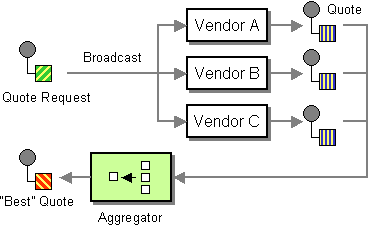Fuse 6 is no longer supported
As of February 2025, Red Hat Fuse 6 is no longer supported. If you are using Fuse 6, please upgrade to Red Hat build of Apache Camel.이 콘텐츠는 선택한 언어로 제공되지 않습니다.
7.13. Scatter-Gather
Scatter-Gather
링크 복사링크가 클립보드에 복사되었습니다!
The scatter-gather pattern, as shown in Figure 7.12, “Scatter-Gather Pattern”, enables you to route messages to a number of dynamically specified recipients and re-aggregate the responses back into a single message.
Figure 7.12. Scatter-Gather Pattern
Dynamic scatter-gather example
링크 복사링크가 클립보드에 복사되었습니다!
The following example outlines an application that gets the best quote for beer from several different vendors. The examples uses a dynamic Recipient List to request a quote from all vendors and an Aggregator to pick the best quote out of all the responses. The routes for this application are defined as follows:
In the first route, the Recipient List looks at the
listOfVendors header to obtain the list of recipients. Hence, the client that sends messages to this application needs to add a listOfVendors header to the message. Example 7.1, “Messaging Client Sample” shows some sample code from a messaging client that adds the relevant header data to outgoing messages.
Example 7.1. Messaging Client Sample
Map<String, Object> headers = new HashMap<String, Object>();
headers.put("listOfVendors", "bean:vendor1, bean:vendor2, bean:vendor3");
headers.put("quoteRequestId", "quoteRequest-1");
template.sendBodyAndHeaders("direct:start", "<quote_request item=\"beer\"/>", headers);
Map<String, Object> headers = new HashMap<String, Object>();
headers.put("listOfVendors", "bean:vendor1, bean:vendor2, bean:vendor3");
headers.put("quoteRequestId", "quoteRequest-1");
template.sendBodyAndHeaders("direct:start", "<quote_request item=\"beer\"/>", headers);
The message would be distributed to the following endpoints:
bean:vendor1, bean:vendor2, and bean:vendor3. These beans are all implemented by the following class:
The bean instances,
vendor1, vendor2, and vendor3, are instantiated using Spring XML syntax, as follows:
Each bean is initialized with a different price for beer (passed to the constructor argument). When a message is sent to each bean endpoint, it arrives at the
MyVendor.getQuote method. This method does a simple check to see whether this quote request is for beer and then sets the price of beer on the exchange for retrieval at a later step. The message is forwarded to the next step using POJO Producing (see the @Produce annotation).
At the next step, we want to take the beer quotes from all vendors and find out which one was the best (that is, the lowest). For this, we use an Aggregator with a custom aggregation strategy. The Aggregator needs to identify which messages are relevant to the current quote, which is done by correlating messages based on the value of the
quoteRequestId header (passed to the correlationExpression). As shown in Example 7.1, “Messaging Client Sample”, the correlation ID is set to quoteRequest-1 (the correlation ID should be unique). To pick the lowest quote out of the set, you can use a custom aggregation strategy like the following:
Static scatter-gather example
링크 복사링크가 클립보드에 복사되었습니다!
You can specify the recipients explicitly in the scatter-gather application by employing a static Recipient List. The following example shows the routes you would use to implement a static scatter-gather scenario:
